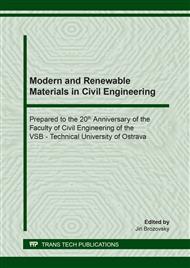[1]
R. Cajka, M. Krejsa, Measured data processing in civil structure using the DOProC method. Advanced Materials Research, Vol. 859, 2014, pp.114-121.
DOI: 10.4028/www.scientific.net/amr.859.114
Google Scholar
[2]
P. Janas, M. Krejsa, Statistical Dependence of Input Variables in DOProc Method. Transactions of the VŠB – Technical University of Ostrava, Civil Engineering Series, vol. 12, 2012, pp.243-252.
DOI: 10.2478/v10160-012-0017-3
Google Scholar
[3]
P. Janas, M. Krejsa, V. Krejsa, Structural reliability assessment using a Direct Determined Probabilistic Calculation. In: Proceedings of the 12th International Conference on Civil, Structural and Environmental Engineering Computing. 2009, 20 p.
DOI: 10.4203/ccp.91.72
Google Scholar
[4]
T. Bobinska, M. Buike, A. Buikis, H. Hee Cho, Transient Heat Transfer with Partial Boiling in System with Double Wall and Double Fins. WSEAS Transactions on Heat and Mass Transfer, Vol. 9, 2014, pp.111-120.
Google Scholar
[5]
M. Krejsa, P. Janas, V. Krejsa, Software Application of the DOProC Method, International Journal of Mathematics and Computers in Simulation, vol. 8. (2014) pp.121-126 (6 p), ISSN: 1998-0159.
Google Scholar
[6]
Azher M. Abed, K. Sopian, M. A. Alghoul, Ali Najah Al-.Shamani, Mohdhafidz Ruslan, Sohif Mat, Parametric Study of Single Effect Combined Absorption-Ejector Cooling System. WSEAS Transactions on Heat and Mass Transfer, Vol. 9, 2014, pp.95-101.
DOI: 10.1088/1757-899x/88/1/012059
Google Scholar
[7]
H. Lahuta, I. Skotnicova, Dynamic thermal performance of building structures in experimental lightweight timber-frame passive house. In: Proceedings of 13th SGEM GeoConference on Nano, Bio And Green – Technologies For A Sustainable Future, 2013, pp.403-410.
DOI: 10.5593/sgem2013/bf6/s26.008
Google Scholar
[8]
Ivan V. Kazachkov, Heat Transfer and Dynamics of the Droplet on a Superheated Surface. WSEAS Transactions on Heat and Mass Transfer, Vol. 7, Issue 2, 2012, pp.47-57.
Google Scholar
[9]
S. Thelandersson, T. Isaksson, Mould resistance design (MRD) model for evaluation of risk for microbial growth under varying climate conditions. Building and Environment, vol. 65, 2013, pp.18-25.
DOI: 10.1016/j.buildenv.2013.03.016
Google Scholar
[10]
M. Krejsa, P. Janas, R. Cajka, Using DOProC method in structural reliability assessment. Applied Mechanics and Materials, vol. 300-301, 2013, pp.860-869.
DOI: 10.4028/www.scientific.net/amm.300-301.860
Google Scholar
[11]
L. Kucerova, M. Cernikova, B. Hruba, Thermal technical assessment of selected constructions of wooden houses. Applied Mechanics and Materials, vol. 470, 2013, pp.988-991.
DOI: 10.4028/www.scientific.net/amm.470.988
Google Scholar
[12]
H.J. Moon, G.L.M. Augenbroe, Towards a practical mould growth risk indicator. Building Services Engineering Research and Technology, vol. 25, Issue 4, 2004, pp.317-326.
DOI: 10.1191/0143624404bt101oa
Google Scholar


